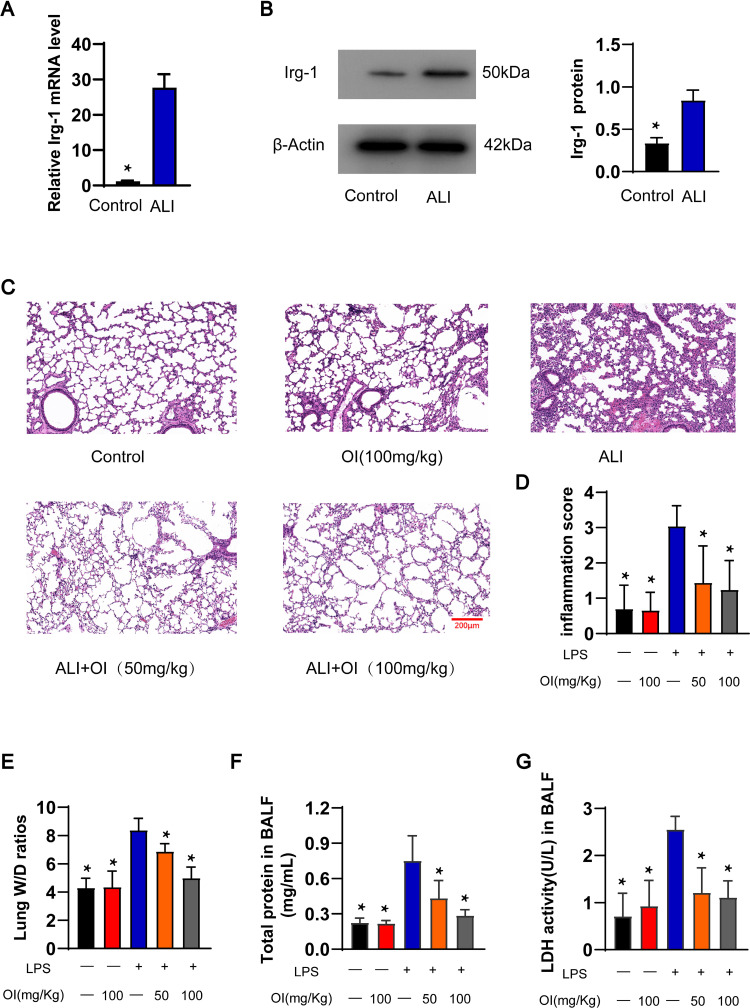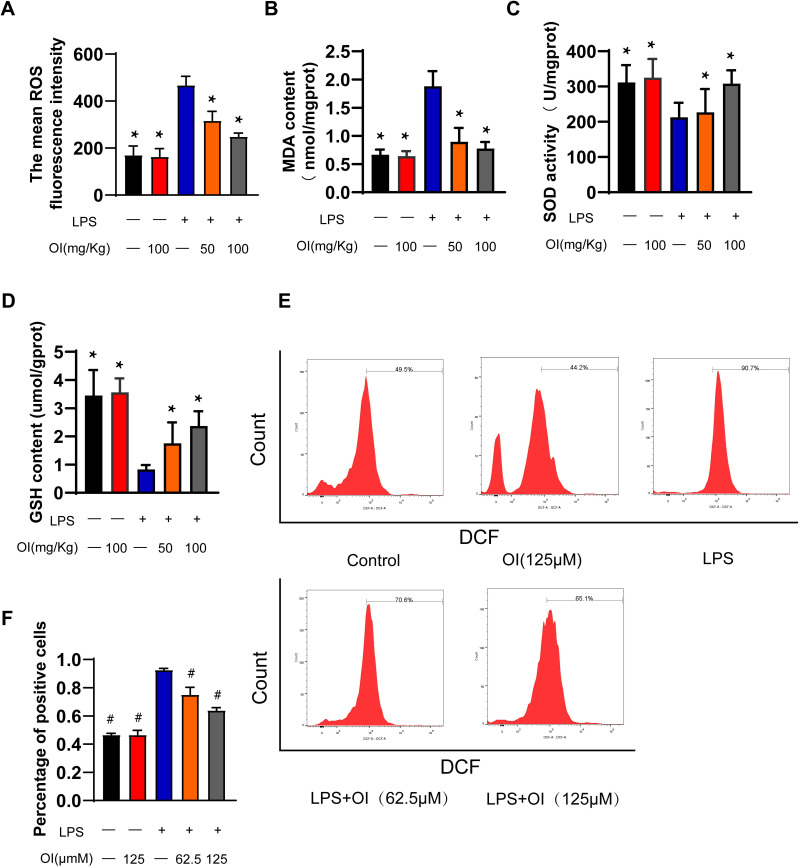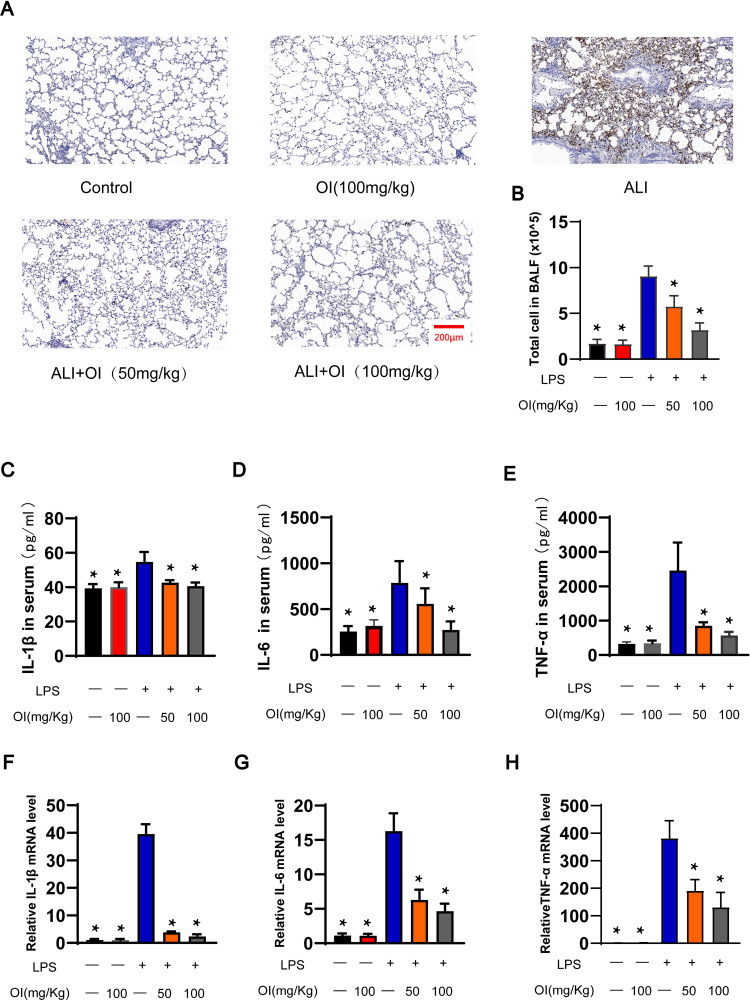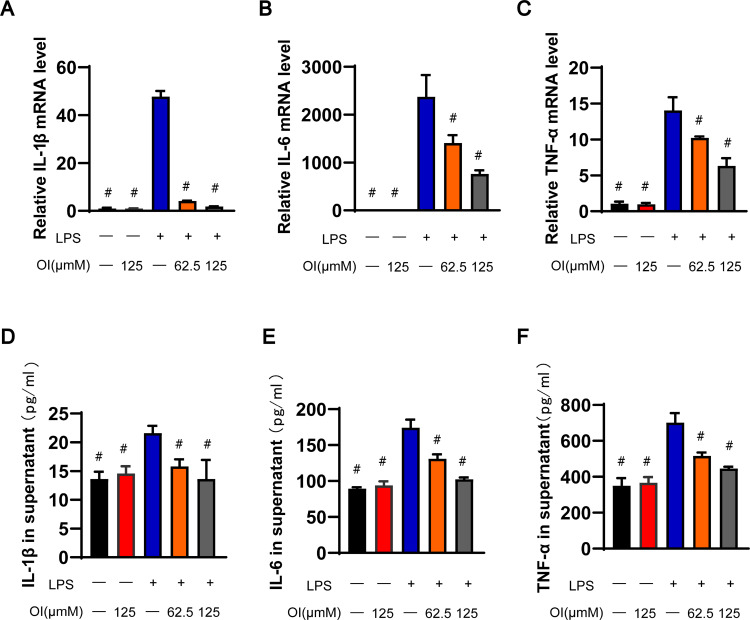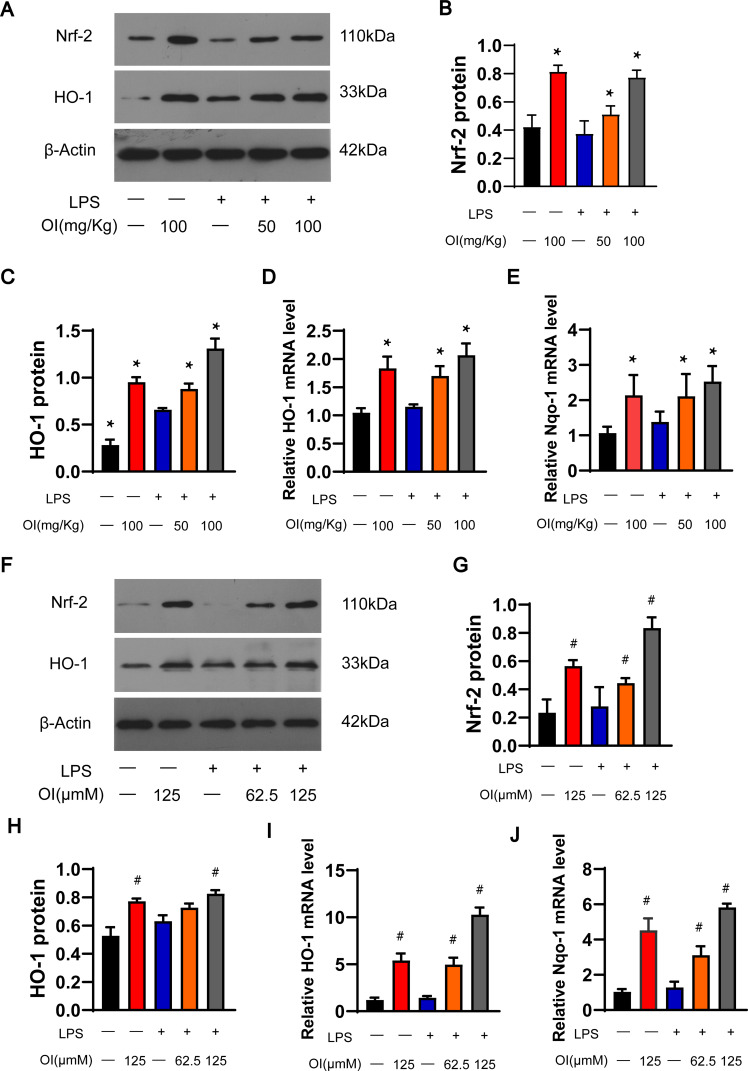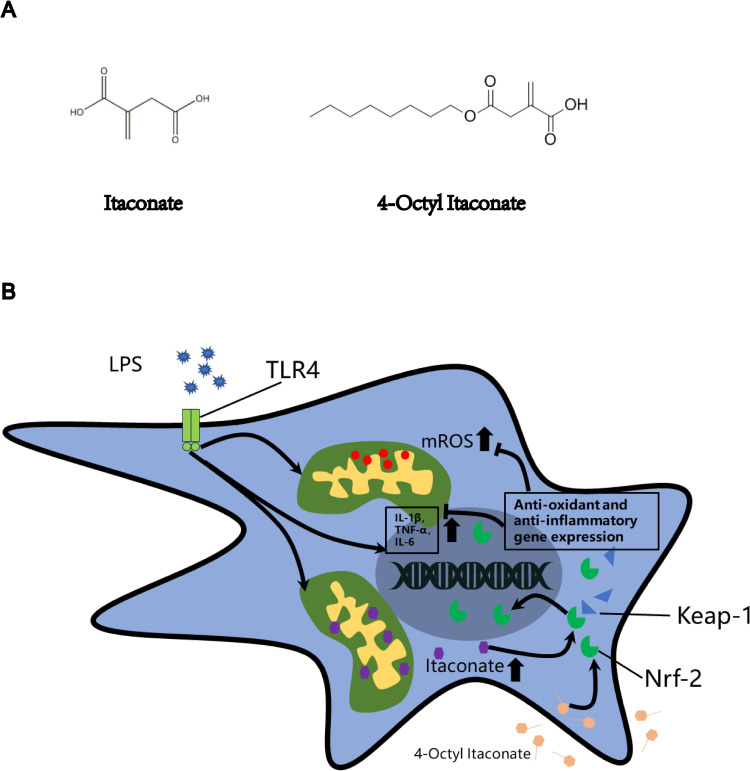Abstract
Background
Acute lung injury (ALI) is a fatal disease in the absence of pharmacological treatment. Oxidative stress and inflammation are closely related to ALI. Innate immune cells are the main source of reactive oxygen species (ROS). Macrophages play an extremely important role in ALI through the activation of inflammation and oxidative stress. Itaconate, a metabolite of tricarboxylic acid, has been reported to have strong antioxidant and anti-inflammatory effects. However, the role of itaconate in ALI is unclear. Herein, we use 4-octyl itaconate (OI), the cellular permeable derivate of itaconate, to study the effects of itaconate in vivo and in vitro.
Methods
We used OI to pretreat C57BL/6 mice and LPS-induced ALI models to illustrate the role of itaconate in acute lung injury. The mice were randomly divided into four groups: control group, OI (100 mg/kg) group, ALI Group, ALI + OI (50 mg/kg) group, and ALI + OI (100 mg/kg) group. RAW264.7 cells were used to further prove the role and mechanism of itaconate in vitro.
Results
According to the H&E staining of the lung, OI was observed to significantly reduce lung inflammation. The active oxygen content of tissues was also significantly reduced (P<0.05). OI reduced the accumulation of neutrophils and secretion of inflammatory factors in LPS-induced ALI (P<0.05). At the cellular level, OI also reduced oxidative stress and inflammation. Intervention with OI was also observed to upregulate the expression of nuclear factor erythroid 2-related factor-2 (Nrf-2) and Nrf-2 target genes in the lung tissue and RAW264.7 cells.
Conclusion
OI alleviates LPS-induced ALI. Moreover, the antioxidant and anti-inflammatory effects of OI might depend on the activation of Nrf-2. Therefore, OI might have therapeutic potential for the treatment of ALI.
Keywords: metabolite, inflammation, reactive oxygen species, acute respiratory distress syndrome, nuclear factor erythroid 2-related factor 2, Nrf-2
Introduction
Acute lung injury (ALI), characterized by diffuse alveolar injury, edema formation in the lung, infiltration of immune cells, and decreased lung compliance, is a clinical syndrome associated with substantial costs, as well as high morbidity and mortality. Acute respiratory distress syndrome (ARDS) is the end stage of ALI.1 Multiple factors causing ALI/ARDS have been identified, including viral infection, high-pressure ventilation, drugs, and other systemic diseases. An effective treatment is not yet available, and patients around the world can only receive supportive treatment.2 Therefore, there is an urgent need to thoroughly investigate the pathogenesis and treatment of ALI/ARDS.
Oxidative stress is among the causative factors of lung tissue injury and plays a major role in ALI/ARDS.3 Although damaging oxidants can arise from endothelial and alveolar epithelial cells, the majority of oxidants are derived from innate immune cells (macrophages and recruited neutrophils) in the injured lung tissue.4 Damaging oxidants may directly cause tissue damage, while some oxidants such as reactive oxygen species (ROS) can act as inflammatory signal molecules to activate NF-κB, HIF-1α, and so on, leading to an inflammatory response that is an important cause of ALI/ARDS.5 Oxidative stress and inflammatory response always reinforce each other in the progression of ALI. An antioxidant system in the body, consisting of endogenous antioxidants such as superoxide dismutase, catalase, and glutathione peroxidase, can be used to eliminate excess oxidants. Nrf-2 is the main signal molecule that regulates antioxidant substances in the body.6 Under physiological conditions, Kelch-like ECH-associated protein-1 (Keap-1) usually binds to the Nrf-2 and promotes its degradation through the ubiquitin-proteasome pathways. Nrf-2 dissociates from Keap-1 and travels to the nucleus to activate the antioxidant response elements (AREs). Several studies have indicated that the activation of Nrf-2 can reduce oxidative stress and inflammatory response.7
Itaconate, a product of the tricarboxylic acid cycle (TCA), is derived from the decarboxylation of cis-aconitic acid by the immune-responsive gene 1 (IRG-1) in the mitochondrial matrix of macrophage.8 Under inflammatory conditions, IRG-1 is upregulated about 200 times, leading to the accumulation of itaconate in large amounts. Itaconate is described as a metabolite that negatively regulates oxidative stress and immune inflammation.9 It can reduce ROS production and block the release of pro-inflammatory cytokines.10 The cellular permeable derivate of itaconate, called 4-octyl itaconate (OI), is hydrolyzed to itaconate by esterases.11 OI can halt the progress of various diseases, including ischemia-reperfusion injury, osteoclast-related diseases, and renal fibrosis, by reducing oxidative stress and modifying the immune response of macrophages to lipopolysaccharide (LPS).12–14
In this study, we elaborate on the protective effects of OI against ALI and investigate the Nrf-2-dependent mechanisms that are related to the reduction of oxidative stress and blockage of the release of pro-inflammatory cytokines.
Materials and Methods
Materials
OI was purchased from MedChemExpress (Monmouth Junction, NJ, USA). LPS (Escherichia coli 0111: B4) and dimethyl sulfoxide (DMSO) were acquired from Sigma (St. Louis, MO, USA). The assay kits for Lactate dehydrogenase (LDH), superoxide dismutase (SOD), and malondialdehyde (MDA) were acquired from Nanjing Jiancheng Bioengineering Institute (Nanjing, China). Primary antibodies against Nrf-2, HO-1, and β-Actin were purchased from Abcam (Cambridge, MA, USA). The fluorometric intracellular ROS kit was purchased from Sigma (St. Louis, MO, USA). Mouse IL-1β ELISA Kit, Mouse IL-6 ELISA Kit, and Mouse TNF-a ELISA Kit were purchased from MultiSciences (Hangzhou, China).
ALI Model and OI Intervention
Male C57BL/6 mice aged 8–10-weeks-old, from HFK BioTechnology Co, Ltd, Beijing, China, were used for this study. All the animals were housed in a specific pathogen-free (SPF) facility. The protocol for generating ALI models was based on a previous study.15 Mice were randomly divided into four groups: Control group, ALI Group, ALI + OI (50 mg/kg) group, and ALI + OI (100 mg/kg) group. Mice in the control group and ALI group were administered DMSO intraperitoneally for three days. In the ALI + OI group, mice were administered OI (50 mg/kg or 100 mg/kg) for three days.16 On the third day, 2 h after the treatment with OI or DMSO, the mice were administered LPS (5 mg/kg) intratracheally. After 12 h, the mice were sacrificed, and the lung samples and bronchoalveolar lavage fluid (BALF) were harvested as described in a previous study. All the animal experiments were reviewed by the ethics committee of the Tongji Medical College of Huazhong University of Science and Technology and conformed to the National Institutes of Health Guide for Care and Use of Laboratory Animals.
Histologic Analysis
The lung tissues were fixed in 4% buffered paraformaldehyde for 48 h, following which they were embedded in paraffin and cut into 4-µm thick sections. These sections were then stained with hematoxylin and eosin (H&E) and immunohistochemically with the anti-Gr-1 antibody. The lung tissue was scored according to the following four items: alveolar congestion; hemorrhage; infiltration or aggregation of neutrophils in airspace or vessel wall; and thickness of the alveolar wall/hyaline membrane formation. A score of 0 represented normal lungs; 1 represented mild lung involvement less than 25%; 2 represented moderate with 25–50% lung involvement; 3 represented severe with 50–75% lung involvement, and 4 represented very severe with more than 75% lung involvement.17 The lung inflammatory score was measured by three blinded pathologists.
Collection and Analysis of Bronchoalveolar Lavage Fluid (BALF)
BALF was obtained by intratracheal instillation with 0.8 mL phosphate buffered saline (PBS) thrice, following, which it was centrifuged at 1500 r/min at 4°C for 10 min. The supernatants were analyzed using the BCA kit to measure the total protein content of BALF, and the pelleted cells were counted by the cell counting plate.
Wet to Dry (W/D) Ratio of the Lung
The left lungs were excised from sacrificed mice and weighed to obtain the wet weight. Then, the samples were placed in an 80 °C drier for about 48 h to obtain the dry weight. From these weights, the lung W/D ratio was calculated.
ELISA
The levels of IL-1β, IL-6, and TNF-α in the conditioned medium or serum were assessed using ELISA kits, according to the manufacturer’s protocols.
RAW264.7 Culture and Intervention
The RAW264.7 cells were purchased from the American Type Culture Collection (ATCC, USA). The cells were cultured in DMEM high sugar medium containing 10% fetal bovine serum (Gibco), 100 U/mL penicillin, and 100 mg/mL streptomycin, and incubated at 37 °C with 5% CO2. To study the effects of OI on the inflammatory response of macrophages, OI (62.5µmol/L and 125µmol/L) was used to pretreat the RAW264.7 cells for 3 h, following which the cells were exposed to LPS (1ug/mL) according to a previous study.18
Lactate Dehydrogenase (LDH) Activity Assay
The LDH activity of BALF was measured using an LDH activity kit, following the manufacturer’s protocols.
Malondialdehyde (MDA) Content, Superoxide Dismutase (SOD) Activity, and Glutathione (GSH) Analysis
The lung tissues were homogenized and centrifuged for 10 min at 3000–4000 rpm. The supernatant was then collected to prepare the 10% tissue homogenate, and the MDA, SOD, and GSH were determined using assay kits according to the manufacturer’s protocols.
RNA Isolation and Real-Time PCR (RT-PCR)
Total RNA from the lung tissues or RAW264.7 cells was extracted using Trizol reagent (Takara Bio, Tokyo, Japan). The RNA was reverse-transcribed using the RNA PCR Kit (Takara Bio, Tokyo, Japan). The quantitative polymerase chain reaction (qPCR) amplification using SYBR Green PCR Master Mix (Takara Bio, Tokyo, Japan) was performed on an ABI PRISM 7900 Sequence Detector System (Applied Biosystems, Foster City, CA). Relative gene expression was calculated by the 2−ΔΔCt method. The primers used are listed in Table 1.
Table 1.
The Primer Sequence Used in Research
| Gene | Forward Primer | Reverse Primer |
|---|---|---|
| Irg-1 | GTTTGGGGTCGACCAGACTT | CAGGTCGAGGCCAGAAAACT |
| HO-1 | GTGACAGAAGAGGCTAAGACCG | ACAGGAAGCTGAGAGTGAGGAC |
| Nqo-1 | TATCACCACTGGGGGTAGCG | GGAGTGTGGCCAATGCTGTAA |
| IL-1β | TCAAATCTCGCAGCAGCACATC | CGTCACACACCAGCAGGTTATC |
| IL-6 | TTCTTGGGACTGATGCTGGTG | GCCATTGCACAACTCTTTTCTC |
| TNF-α | ACCCTCACACTCACAAACCA | ATAGCAAATCGGCTGACGGT |
| GAPDH | CCTCGTCCCGTAGACAAAATG | TGAGGTCAATGAAGGGGTCGT |
Western Blot Analysis
The lung or cells were extracted in RIPA buffer with protease inhibitor. The total proteins were quantified using the BCA kit (Thermo Fisher Scientific, USA). The proteins were separated on SDS polyacrylamide mini-gels and then transferred to PVDF membranes (Sigma-Aldrich, USA). The PVDF membranes were blocked in 5% skimmed milk for 1 h and incubated overnight with primary antibodies against β-actin (Rabbit, 1:10000, ab179467, Abcam), HO-1 (Rabbit, 1:2000, ab189491, Abcam), Nrf2 (Rabbit, 1:1000, ab137550, Abcam), and IRG-1 (Rabbit, 1:1000, ab 222411, Abcam) at 4°C. Then, the membranes were incubated with a secondary antibody (HRP-Goat anti-Rabbit, 1:3000, E-AB-1037, Elabscience) for 1 h at room temperature. An imaging system with an ECL kit (Bio-Rad, Hercules, CA) was used to detect the reactions. The protein was quantified using AlphaEaseFC (AlphaInnotech, USA).
Reactive Oxygen Species (ROS) Flow Cytometry
A combination of mechanical and enzymatic treatment is used to obtain single cell of lung tissue. Firstly, we obtain lung tissue homogenate through homogenizer (MediMachineII. Syntec). Tissue homogenate is incubated for 30 min at 37°C with Collagenase D(2mg/mL) and DNase I(80U/mL). Then those samples were filtered through a 70 μm nylon mesh filter.19 After centrifugation, the red blood cell lysis buffer is used to remove the remaining red blood cells. Cells from the lung tissue or RAW264.7 cells were stained with the Fluorometric Intracellular ROS Kit (Sigma, USA) for 40 min. After washing, the labeled cells were analyzed using the software FACSCalibur (BD Immunocytometry Systems).
Statistical Analysis
The results of the experiment were presented as the means ±standard deviation (SD). Unpaired Student’s t-test and one-way analysis of variance (ANOVA) were used to analyze the data. All the results were analyzed using the statistical program SPSS 21.0 (IBM, USA). A p-value < 0.05 was considered to be statistically significant.
Results
OI Attenuates Acute Lung Tissue Injury Induced by LPS
IRG-1 can catalyze the conversion of isocitrate to itaconate on the mitochondrial membrane.9 We detected the expression of IRG-1 in mouse. The results show that IRG-1 is upregulated in acute lung tissue (Figure 1A and B). In order to further study the role of itaconate in acute lung tissue injury, we have used animal models to assess the role of OI in ALI. The histopathology indicated that OI reduced the LPS-induced pulmonary edema, hemorrhage and inflammatory cell infiltration (Figure 1C). Similarly, the inflammation scores of OI intervention groups were lower than those of the ALI group (Figure 1D). The W/D ratio was used to assess the degree of pulmonary edema. This ratio showed a significant difference between OI pretreatment groups and the ALI group (Figure 1E). Total protein in BALF and LDH activity were also used as indicators to assess the severity of lung injury. Pretreatment with OI remarkably decreased the protein exudation and cellular damage (Figure 1F and G). These findings suggested that OI could alleviate acute lung tissue injury induced by LPS.
Figure 1.
OI attenuates acute lung tissue injury induced by LPS. Mice were pretreated with OI (50 mg/kg, 100 mg/kg) or DMSO for three days by intraperitoneal injection, following which, LPS was injected through the trachea. The lung tissue was collected 12 h later. The expression level of Irg-1 is shown (A and B, n = 3).H&E staining and inflammation score are presented (C and D, n = 6), Scale bars: 200 µm. The lung W/D ratio indicates the degree of pulmonary edema (E, n =6). The total protein in BALF was measured using the BAC kit (F, n = 6). LDH activity in BALF is an indicator of lung injury (G, n = 6). The results are presented as means ±SD. *P < 0.05 compared with ALI group.
OI Attenuates Oxidative Stress in vivo and in vitro
The oxidative stress response is also involved in ALI and results in pulmonary fibrosis during the final stages of ALI.20 To understand the role of OI in oxidative stress response, we measured the mean ROS fluorescence intensity in lung tissue using flow cytometry. The results indicate that the generation of ROS was suppressed by OI (Figure 2A). MDA is the final decomposition product of membrane lipid peroxidation. Its content reflects the intensity of oxidative stress in the organism. We observed that MDA content in the lung tissues of mice pretreated with OI was lower than the ALI group (Figure 2B). In the mice pretreated with 100 mg/kg OI, the levels of substances such as SOD and GSH, which act against oxidative stress, were higher than those in the ALI group (Figure 2C and D). Phagocytic cells (macrophages and neutrophils) represent the most important source of damaging oxidants by releasing NADPH oxidase in the lung tissue. We evaluated the generation of ROS in LPS-induced macrophages in vitro. The proportion of ROS-positive macrophages decreased significantly after OI pretreatment. (Figure 2E and F)
Figure 2.
Anti-oxidative effect of OI. ROS content was detected by flow cytometry in lung tissue and the mean ROS fluorescence intensity is presented (A, n = 6). MDA content, SOD activity, GSH content are presented (B–D, n = 6). The RAW264.7 cells were pretreated with OI (62.5µM, 125µM), followed by LPS (1µg/mL) stimulation for 24 h. ROS generation of LPS-induced macrophages are presented (E and F, n = 3). The results are shown as means ±SD. *P < 0.05 compared with ALI group. #P < 0.05 compared with the group only treated by 1μg/mL LPS.
OI Suppresses Inflammatory Response via Interfering with Macrophages
Neutrophil accumulation is a feature of acute inflammatory response.21 This study demonstrated that OI significantly alleviated the accumulation of neutrophils in the damaged lung tissue (Figure 3A) and reduced the total number of cells in BALF (Figure 3B). Pro-inflammatory cytokines are essential for the initiation and maintenance of the inflammatory response. In ALI patients, high levels of pro-inflammatory factors have been reported.22 This study revealed that OI inhibited the release of pro-inflammatory factors, such as IL-1β, IL-6, and TNF-α in mice (Figure 3C–E). We also tested the expression of inflammatory factors in lung tissue (Figure 3F–H). The accumulation of macrophages in acute lung tissue injury has been reported.23 Macrophages can regulate the direction of the inflammatory response. We observed that OI reduced the transcription of pro-inflammatory factors (IL-1β, IL-6, and TNF-α) in RAW264.7 cells (Figure 4A–F). Thus, OI can inhibit the inflammatory response in mice and relieve acute lung tissue injury by interfering with macrophages.
Figure 3.
OI reduces the inflammatory response in mice. Gr-1 was used to assess the degree of neutrophil infiltration by immunohistochemical staining (A, n = 6), Scale bars: 200 µm. The total cell counts in BALF were determined (B, n = 6). The content of IL-1β, IL-6, and TNF-α in serum was measured by ELISA (C–E, n = 6). The transcription of the inflammatory factor IL-1β, IL-6, and TNF-α was tested by qPCR (F–H, n = 3). The results are presented as means ±SD. *P < 0.05 compared with ALI group.
Figure 4.
OI reduces the release of inflammatory factors in vitro. The RAW264.7 cells were pretreated with OI (62.5µM, 125µM), followed by LPS (1µg/mL) stimulation. The level of IL-1β, IL-6, and TNF-α at 6 h was detected by qPCR (A–C, n=3). IL-1β, IL-6, and TNF-α contents in the supernatant were determined 24 h after LPS stimulation (D–F, n=3). The results are presented as means ±SD. #P < 0.05 compared with the group only treated by 1μg/mL LPS.
OI Activates Nrf-2 Signaling Pathway to Suppress Oxidative Stress and Inflammation
Oxidative stress and inflammation play an important role in LPS-induced ALI. We observed that OI reduced both oxidative stress and inflammation in lung tissue. This effect could be dependent on Nrf-2. The level of Nrf-2 was upregulated in the lung tissues of rats pretreated with OI (Figure 5A and B). After dissociating from keap1, Nrf-2 enters the cell nucleus to initiate transcription of the antioxidant genes.24 Nrf-2 target genes were detected by Real-time PCR and Western blot. The expression of HO-1 and Nqo-1 was significantly increased in the OI group (Figure 5C–E). Finally, we verified OI-induced Nrf-2 expression against LPS-induced oxidative stress and inflammation in vitro. The results indicated that Nrf-2 and HO-1 protein levels are upregulated after pretreatment with OI (Figure 5F–H). The RT-PCR results show that Nrf-2-target genes were also upregulated (Figure 5I and J). Those findings suggest that OI could activate Nrf-2 to suppress oxidative stress and inflammation (Figure 6A and B).
Figure 5.
OI activates Nrf-2-dependent antioxidant and anti-inflammatory effects. Nrf-2 and Nrf-2-target genes were upregulated by OI. The expression of Nrf-2, HO-1, and Nqo-1 in lung tissue are presented (A–E, n = 3). RAW264.7 cells were pretreated with OI (3 h), followed by stimulation with LPS (1µg/mL). The protein content of Nrf-2 and HO-1 was measured by Western blot (F–H, n = 3), and the mRNA of HO-1 and Nqo-1 (6 h) was detected by qPCR (I and J, n = 3). The results are presented as means ±SD. *P < 0.05 compared with ALI group. #P < 0.05 compared with the group only treated by 1μg/mL LPS.
Figure 6.
The mechanism of action of itaconate/4-octyl itaconate in the alleviation of ALI. The chemical structure of itaconate and its derivative 4-octyl itaconate (A). 4-octyl itaconate activates antioxidant genes in the nucleus through the Nrf-2 protein. The Nrf-2 protein might reduce the production of mitochondrial ROS, as well as the release of inflammatory factors such as IL-1β, TNF-α, and IL-6 (B).
Discussion
The findings of our study suggest that OI can alleviate ALI. OI significantly reduced the content of ROS and increased the activity of antioxidants in lung tissue. The increased transcription of HO-1 also indicated that OI could influence antioxidant elements. Our study has demonstrated that the infiltration of neutrophils and pro-inflammatory factors (IL-1β, IL-6, and TNF-α) in the serum is reduced following OI pretreatment of LPS-induced ALI patients. Under in vitro conditions, OI promoted the transcription of antioxidant genes in RAW264.7 and reduced the inflammatory response of RAW264.7 to LPS stimulation. Thus, the itaconate-dependent metabolic regulation is attributed to the regulation of macrophage-related oxidative stress and inflammatory response.
Macrophages, a type of natural immune cells, are indispensable for the initiation and maintenance of the inflammatory response and are considered to be the main source of ROS in lung tissue.10 Macrophages have been demonstrated to play a role in lung homeostasis, pulmonary fibrosis, allergic asthma, and lung injury.25,26 Studies have also confirmed the central role of inflammatory macrophages in the progression of ALI.27 Activated macrophages can release pro-inflammatory cytokines and recruit neutrophils to cause ALI. They can directly damage lung tissue by generating cytotoxic ROS and reactive nitrogen species (RNS). Since macrophages represent a special population with high heterogeneity,28 we might reverse the progression of the disease by altering the function of macrophages.
Itaconate has been demonstrated that metabolites participate in and regulate the phenotype and function of immune cells.29 Previous research has demonstrated that itaconate is upregulated under inflammatory conditions and plays an important role in inhibiting inflammation.11 It may potentially impact multiple diseases, including psoriasis, multiple sclerosis, mastitis, sepsis, and organ ischemia/reperfusion injury.30–32 In our study, exogenous itaconate (4-octyl itaconate) upregulated the content of Nrf-2 in lung tissue. Mass spectrometry of LPS-activated bone marrow-derived macrophages (BMDMs) showed that endogenous itaconate targeted Keap-1 by modifying cysteine.9 Nrf-2 initiated the transcription of antioxidant genes, including HO-1, SOD, and GSH.33 The anti-oxidative effect of OI might be related to high Nrf-2 levels in the nucleus. A previous study has demonstrated using Chromatin Immunoprecipitation (ChIP) that Nrf-2 is directly bound to the promoter regions of IL-1β and IL-6.34 Nrf-2 reduced the production of mitochondrial ROS (mROS) to inhibit the hypoxia-inducible factor 1α (HIF-1α)/IL-1β signaling pathway by promoting the level of antioxidants.35 In our study, OI reduced the expression of the inflammatory cytokines (IL-β, IL-6, and TNF-α) that could aggravate ALI by increasing lung inflammation. A previous study suggested that OI may inhibit the activity of succinate dehydrogenase (SDH) and regulate the IκBζ–ATF3 inflammatory axis.36 The other downstream signal pathways of itaconate in ALI need further research.
There are some limitations to our study. Although we observed that the expression of IRG-1 was upregulated in LPS-induced lung injury, the expression and role of endogenous itaconate were unclear. Ren et al reported that endogenous IRG-1 was upregulated in viral pneumonia, and inhibiting the expression of IRG-1 could reduce the production of ROS.37 The production of ROS induced by IRG-1 could be related to the antiviral activity of IRG-1. Recent studies have reported that IRG-1/itaconate could resist multiple viral infections, such as SARS-CoV-2, Zika virus, and Herpes Simplex Virus-1 and-2, through Nrf-2 signaling.38 The role of endogenous itaconic acid needs further research. Secondly, human ALI/ARDS is caused by multiple major and minor factors. LPS-induced lung injury models cannot accurately duplicate all the features of human ALI/ARDS, and the drug administration scheme may affect the relevance of animal data to the outcomes of human studies.39
In conclusion, our work has shown that itaconate alleviates ALI/ARDS in mice by inhibiting oxidative stress and inflammation. Nrf-2 acts as a bridge in this process by regulating the expression of downstream antioxidant genes and inflammatory genes. Thus, OI may represent a novel method to treat ALI through the early intervention of macrophage-related oxidative stress and inflammatory response.
Conclusion
Our research demonstrated that OI could reduce oxidative stress and inhibit inflammation. OI may protect lung tissue through the activation of the antioxidant factor Nrf-2. OI has potential applications as a novel drug for the treatment of ALI.
Acknowledgments
We are very grateful to Xing Liu, and Rui Li for their technical support. We are also very grateful to Qiaofeng Qian for his guidance.
Funding Statement
This research was supported by the National Natural Science Foundation of China (No. 81974039 and 81570427).
Disclosure
The authors declare no conflicts of interest in this work.
References
- 1.Mowery NT, Terzian WTH, Nelson AC. Acute lung injury. Curr Probl Surg. 2020;57(5):100777. doi: 10.1016/j.cpsurg.2020.100777 [DOI] [PubMed] [Google Scholar]
- 2.Schmidt GA. Managing acute lung injury. Clin Chest Med. 2016;37(4):647–658. doi: 10.1016/j.ccm.2016.07.005 [DOI] [PubMed] [Google Scholar]
- 3.Kellner M, Noonepalle S, Lu Q, Srivastava A, Zemskov E, Black SM. ROS signaling in the pathogenesis of acute lung injury (ALI) and acute respiratory distress syndrome (ARDS). Adv Exp Med Biol. 2017;967:105–137. [DOI] [PMC free article] [PubMed] [Google Scholar]
- 4.Ward PA. Oxidative stress: acute and progressive lung injury. Ann N Y Acad Sci. 2010;1203:53–59. doi: 10.1111/j.1749-6632.2010.05552.x [DOI] [PubMed] [Google Scholar]
- 5.Mittal M, Siddiqui MR, Tran K, Reddy SP, Malik AB. Reactive oxygen species in inflammation and tissue injury. Antioxid Redox Signal. 2014;20(7):1126–1167. doi: 10.1089/ars.2012.5149 [DOI] [PMC free article] [PubMed] [Google Scholar]
- 6.Lin J, Shi Y, Miao J, et al. Gastrodin alleviates oxidative stress-induced apoptosis and cellular dysfunction in human umbilical vein endothelial cells via the nuclear factor-erythroid 2-related factor 2/heme oxygenase-1 pathway and accelerates wound healing in vivo. Front Pharmacol. 2019;10:1273. doi: 10.3389/fphar.2019.01273 [DOI] [PMC free article] [PubMed] [Google Scholar]
- 7.Zhao H, Eguchi S, Alam A, Ma D. The role of nuclear factor-erythroid 2 related factor 2 (Nrf-2) in the protection against lung injury. Am J Physiol Lung Cell Mol Physiol. 2017;312(2):L155–l162. doi: 10.1152/ajplung.00449.2016 [DOI] [PubMed] [Google Scholar]
- 8.Michelucci A, Cordes T, Ghelfi J, et al. Immune-responsive gene 1 protein links metabolism to immunity by catalyzing itaconic acid production. Proc Natl Acad Sci U S A. 2013;110(19):7820–7825. doi: 10.1073/pnas.1218599110 [DOI] [PMC free article] [PubMed] [Google Scholar]
- 9.Mills EL, Ryan DG, Prag HA, et al. Itaconate is an anti-inflammatory metabolite that activates Nrf2 via alkylation of KEAP1. Nature. 2018;556(7699):113–117. doi: 10.1038/nature25986 [DOI] [PMC free article] [PubMed] [Google Scholar]
- 10.Mills EL, Kelly B, Logan A, et al. Succinate dehydrogenase supports metabolic repurposing of mitochondria to drive inflammatory macrophages. Cell. 2016;167(2):457–470. doi: 10.1016/j.cell.2016.08.064 [DOI] [PMC free article] [PubMed] [Google Scholar]
- 11.Hooftman A, O’Neill LAJ. The immunomodulatory potential of the metabolite itaconate. Trends Immunol. 2019;40(8):687–698. doi: 10.1016/j.it.2019.05.007 [DOI] [PubMed] [Google Scholar]
- 12.Cordes T, Lucas A, Divakaruni AS, Murphy AN, Cabrales P, Metallo CM. Itaconate modulates tricarboxylic acid and redox metabolism to mitigate reperfusion injury. Mol Metab. 2020;32:122–135. doi: 10.1016/j.molmet.2019.11.019 [DOI] [PMC free article] [PubMed] [Google Scholar]
- 13.Tian F, Wang Z, He J, Zhang Z, Tan N. 4-Octyl itaconate protects against renal fibrosis via inhibiting TGF-beta/Smad pathway, autophagy and reducing generation of reactive oxygen species. Eur J Pharmacol. 2020;873:172989. doi: 10.1016/j.ejphar.2020.172989 [DOI] [PubMed] [Google Scholar]
- 14.Bailey JD, Diotallevi M, Nicol T, et al. Nitric oxide modulates metabolic remodeling in inflammatory macrophages through TCA cycle regulation and itaconate accumulation. Cell Rep. 2019;28(1):218–230. doi: 10.1016/j.celrep.2019.06.018 [DOI] [PMC free article] [PubMed] [Google Scholar]
- 15.Huang XT, Liu W, Zhou Y, et al. Galectin-1 ameliorates lipopolysaccharide-induced acute lung injury via AMPK-Nrf2 pathway in mice. Free Radic Biol Med. 2020;146:222–233. [DOI] [PubMed] [Google Scholar]
- 16.Sun X, Zhang B, Pan X, et al. Octyl itaconate inhibits osteoclastogenesis by suppressing Hrd1 and activating Nrf2 signaling. FASEB J. 2019;33(11):12929–12940. doi: 10.1096/fj.201900887RR [DOI] [PMC free article] [PubMed] [Google Scholar]
- 17.Wolthuis EK, Vlaar AP, Choi G, Roelofs JJ, Juffermans NP, Schultz MJ. Mechanical ventilation using non-injurious ventilation settings causes lung injury in the absence of pre-existing lung injury in healthy mice. Crit Care. 2009;13(1):R1. doi: 10.1186/cc7688 [DOI] [PMC free article] [PubMed] [Google Scholar]
- 18.Liao ST, Han C, Xu DQ, Fu XW, Wang JS, Kong LY. 4-Octyl itaconate inhibits aerobic glycolysis by targeting GAPDH to exert anti-inflammatory effects. Nat Commun. 2019;10(1):5091. doi: 10.1038/s41467-019-13078-5 [DOI] [PMC free article] [PubMed] [Google Scholar]
- 19.Jungblut M, Oeltze K, Zehnter I, Hasselmann D, Bosio A. Standardized preparation of single-cell suspensions from mouse lung tissue using the gentleMACS Dissociator. J Vis Exp. 2009;29. [DOI] [PMC free article] [PubMed] [Google Scholar]
- 20.Sun XQ, Wu C, Qiu YB, et al. Heme oxygenase-1 attenuates seawater drowning-induced acute lung injury through a reduction in inflammation and oxidative stress. Int Immunopharmacol. 2019;74:105634. doi: 10.1016/j.intimp.2019.05.019 [DOI] [PubMed] [Google Scholar]
- 21.Narasaraju T, Yang E, Samy RP, et al. Excessive neutrophils and neutrophil extracellular traps contribute to acute lung injury of influenza pneumonitis. Am J Pathol. 2011;179(1):199–210. doi: 10.1016/j.ajpath.2011.03.013 [DOI] [PMC free article] [PubMed] [Google Scholar]
- 22.Mokra D, Kosutova P. Biomarkers in acute lung injury. Respir Physiol Neurobiol. 2015;209:52–58. doi: 10.1016/j.resp.2014.10.006 [DOI] [PubMed] [Google Scholar]
- 23.Johnston LK, Rims CR, Gill SE, McGuire JK, Manicone AM. Pulmonary macrophage subpopulations in the induction and resolution of acute lung injury. Am J Respir Cell Mol Biol. 2012;47(4):417–426. doi: 10.1165/rcmb.2012-0090OC [DOI] [PMC free article] [PubMed] [Google Scholar]
- 24.Yang H, Lv H, Li H, Ci X, Peng L. Oridonin protects LPS-induced acute lung injury by modulating Nrf2-mediated oxidative stress and Nrf2-independent NLRP3 and NF-κB pathways. Cell Commun Signal. 2019;17(1):62. doi: 10.1186/s12964-019-0366-y [DOI] [PMC free article] [PubMed] [Google Scholar]
- 25.Saradna A, Do DC, Kumar S, Fu QL, Gao P. Macrophage polarization and allergic asthma. Transl Res. 2018;191:1–14. doi: 10.1016/j.trsl.2017.09.002 [DOI] [PMC free article] [PubMed] [Google Scholar]
- 26.Laskin DL, Malaviya R, Laskin JD. Role of macrophages in acute lung injury and chronic fibrosis induced by pulmonary toxicants. Toxicol Sci. 2019;168(2):287–301. doi: 10.1093/toxsci/kfy309 [DOI] [PMC free article] [PubMed] [Google Scholar]
- 27.Soni S, Wilson MR, O’Dea KP, et al. Alveolar macrophage-derived microvesicles mediate acute lung injury. Thorax. 2016;71(11):1020–1029. doi: 10.1136/thoraxjnl-2015-208032 [DOI] [PMC free article] [PubMed] [Google Scholar]
- 28.Varol C, Mildner A, Jung S. Macrophages: development and tissue specialization. Annu Rev Immunol. 2015;33:643–675. doi: 10.1146/annurev-immunol-032414-112220 [DOI] [PubMed] [Google Scholar]
- 29.Yu XH, Zhang DW, Zheng XL, Tang CK. Itaconate: an emerging determinant of inflammation in activated macrophages. Immunol Cell Biol. 2019;97(2):134–141. [DOI] [PubMed] [Google Scholar]
- 30.Zhao C, Jiang P, He Z, et al. Dimethyl itaconate protects against lippolysacchride-induced mastitis in mice by activating MAPKs and Nrf2 and inhibiting NF-kappaB signaling pathways. Microb Pathog. 2019;133:103541. doi: 10.1016/j.micpath.2019.05.024 [DOI] [PubMed] [Google Scholar]
- 31.Gu L, Lin J, Wang Q, et al. Dimethyl itaconate protects against fungal keratitis by activating the Nrf2/HO-1 signaling pathway. Immunol Cell Biol. 2020;98(3):229–241. doi: 10.1111/imcb.12316 [DOI] [PMC free article] [PubMed] [Google Scholar]
- 32.Yi Z, Deng M, Scott MJ, et al. IRG1/itaconate activates Nrf2 in hepatocytes to protect against liver ischemia–reperfusion injury. Hepatology. 2020. doi: 10.1002/hep.31147 [DOI] [PMC free article] [PubMed] [Google Scholar]
- 33.Abdelrahman RS, Abdel-Rahman N. Dimethyl fumarate ameliorates acetaminophen-induced hepatic injury in mice dependent of Nrf-2/HO-1 pathway. Life Sci. 2019;217:251–260. doi: 10.1016/j.lfs.2018.12.013 [DOI] [PubMed] [Google Scholar]
- 34.Song H, Xu T, Feng X, et al. Itaconate prevents abdominal aortic aneurysm formation through inhibiting inflammation via activation of Nrf2. EBioMedicine. 2020;57:102832. doi: 10.1016/j.ebiom.2020.102832 [DOI] [PMC free article] [PubMed] [Google Scholar]
- 35.Lampropoulou V, Sergushichev A, Bambouskova M, et al. Itaconate links inhibition of succinate dehydrogenase with macrophage metabolic remodeling and regulation of inflammation. Cell Metab. 2016;24(1):158–166. doi: 10.1016/j.cmet.2016.06.004 [DOI] [PMC free article] [PubMed] [Google Scholar]
- 36.Bambouskova M, Gorvel L, Lampropoulou V, et al. Electrophilic properties of itaconate and derivatives regulate the IκBζ–ATF3 inflammatory axis. Nature. 2018;556(7702):501–504. doi: 10.1038/s41586-018-0052-z [DOI] [PMC free article] [PubMed] [Google Scholar]
- 37.Ren K, Lv Y, Zhuo Y, et al. Suppression of IRG-1 reduces inflammatory cell infiltration and lung injury in respiratory syncytial virus infection by reducing production of reactive oxygen species. J Virol. 2016;90(16):7313–7322. doi: 10.1128/JVI.00563-16 [DOI] [PMC free article] [PubMed] [Google Scholar]
- 38.Olagnier D, Farahani E, Thyrsted J, et al. SARS-CoV2-mediated suppression of NRF2-signaling reveals potent antiviral and anti-inflammatory activity of 4-octyl-itaconate and dimethyl fumarate. Nat Commun. 2020;11(1):4938. doi: 10.1038/s41467-020-18764-3 [DOI] [PMC free article] [PubMed] [Google Scholar]
- 39.Chen H, Bai C, Wang X. The value of the lipopolysaccharide-induced acute lung injury model in respiratory medicine. Expert Rev Respir Med. 2010;4(6):773–783. doi: 10.1586/ers.10.71 [DOI] [PubMed] [Google Scholar]



